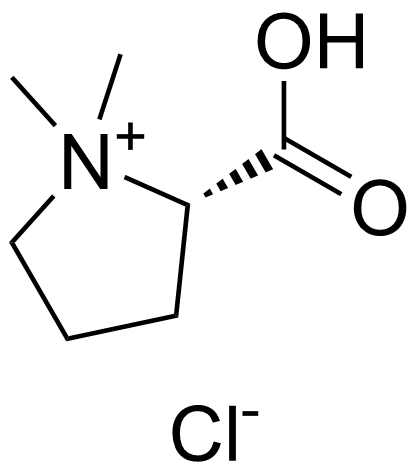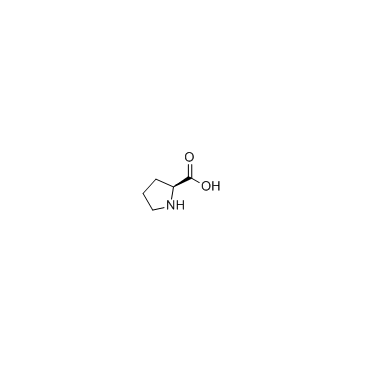4136-37-2
| Name | Stachydrine hydrochloride |
|---|---|
| Synonyms |
EINECS 223-957-8
(2S)-1,1-Dimethylpyrrolidinium-2-carboxylate hydrochloride (1:1) stachydrine HCl pyrrolidinium, 2-carboxy-1,1-dimethyl-, chloride, (2S)- (1:1) MFCD00060174 (2S)-1,1-Dimethyl-2-pyrrolidiniumcarboxylathydrochlorid Pyrrolidinium, 2-carboxy-1,1-dimethyl-, inner salt, (2S)-, hydrochloride (1:1) 1,1-Dimethyl-2-pyrrolidiniumcarboxylate hydrochloride (1:1) (2S)-1,1-Diméthyl-2-pyrrolidiniumcarboxylate chlorhydrate (2S)-1,1-Dimethyl-2-pyrrolidiniumcarboxylate hydrochloride (1:1) (2S)-1,1-Dimethyl-2-pyrrolidiniumcarboxylate hydrochloride (2S)-2-Carboxy-1,1-dimethylpyrrolidinium chloride stachydrine hydrochloride Pyrrolidinium, 2-carboxy-1,1-dimethyl-, inner salt, hydrochloride (1:1) UNII:19Z024IC5E |
| Description | Stachydrine hydrochloride is the major active constituent of Herba Leonuri, which is a potential therapy for cardiovascular diseases[2]. Stachydrine can inhibit the NF-κB signal pathway. Anti-hypertrophic activities[1]. |
|---|---|
| Related Catalog | |
| Target |
p65 |
| In Vitro | Intervention of Stachydrine significantly suppresses the level of p-IκB (ser32) protein in the cytosol and NF-κB (p65) protein in the nucleus (P<0.05)[1]. Treatment with Stachydrine hydrochloride (50 µM, 200 µM, 500 µM and 1000 µM) noticeably inhibited MCF-7 and T47D cell proliferation in dose- and time-dependent manner. High concentrations (500 µM and 1000 µM) of Stachydrine significantly increased the frequency of both studied cell lines at the G1 phase of cell cycle, suggesting that Stachydrine hydrochloride could cause cell cycle arrest[2]. |
| Cell Assay | Cell Proliferation Assay[2] Cell Cycle Analysis[2] MCF-7 and T47D cells 50 µM, 200 µM, 500 µM and 1000 µM 24 and 48 hours CCK-8 cell counting assay is used to detect proliferation of MCF-7 and T47D cells when treated with Stachydrine hydrochloride at four different concentrations (50 µM, 200 µM, 500 µM and 1000 µM) for 24 and 48 hours. Cell cycle analysis of MCF-7 and T47D cells is determined by flow cytometry. Experiments are performed in triplicates and representative images are presented. Note: Inhibited proliferation and induced G1 phase arrest in MCF-7 and T47D cells. [1] Guo W, et al. Effect of Leonurus Stachydrine on myocardial cell hypertrophy. Zhong Yao Cai. 2012 Jun;35(6):940-3.https://www.ncbi.nlm.nih.gov/pubmed/23236831[2] Am J Transl Res. 2017 Apr 15;9(4):1834-1844. eCollection 2017.Stachydrine hydrochloride inhibits proliferation and induces apoptosis of breast cancer cells via inhibition of Akt and ERK pathways.Wang M1, Shu ZJ1, Wang Y1, Peng W1https://www.ncbi.nlm.nih.gov/pubmed/28469788 |
| References |
| Melting Point | 225ºC |
|---|---|
| Molecular Formula | C7H14ClNO2 |
| Molecular Weight | 179.645 |
| Exact Mass | 179.071304 |
| PSA | 40.13000 |
|
~90% 
4136-37-2 |
| Literature: Woster; Murray Journal of Medicinal Chemistry, 1986 , vol. 29, # 5 p. 865 - 868 |
| HS Code | 2933990090 |
|---|---|
| Summary | 2933990090. heterocyclic compounds with nitrogen hetero-atom(s) only. VAT:17.0%. Tax rebate rate:13.0%. . MFN tariff:6.5%. General tariff:20.0% |


